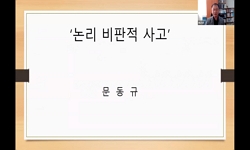This study is a proposal which is the trial to explicate in neurology on how critical thinking as a creative method of sciences functions. The creative methods of sciences even at present are mostly the hypothetical insistences concerning with the log...
http://chineseinput.net/에서 pinyin(병음)방식으로 중국어를 변환할 수 있습니다.
변환된 중국어를 복사하여 사용하시면 됩니다.
- 中文 을 입력하시려면 zhongwen을 입력하시고 space를누르시면됩니다.
- 北京 을 입력하시려면 beijing을 입력하시고 space를 누르시면 됩니다.

창의적 과학방법으로서 철학의 비판적 사고: 신경철학적 해명 = The Critical Thinking of Philosophy as a Creative Method of Science: Neurophilosophical Explication
한글로보기https://www.riss.kr/link?id=A99606715
- 저자
- 발행기관
- 학술지명
- 권호사항
-
발행연도
2013
-
작성언어
-
- 주제어
-
KDC
300
-
등재정보
KCI등재
-
자료형태
학술저널
- 발행기관 URL
-
수록면
144-160(17쪽)
-
KCI 피인용횟수
7
- DOI식별코드
- 제공처
-
0
상세조회 -
0
다운로드
부가정보
다국어 초록 (Multilingual Abstract)
This study is a proposal which is the trial to explicate in neurology on how critical thinking as a creative method of sciences functions. The creative methods of sciences even at present are mostly the hypothetical insistences concerning with the logical processes of researches suggested from the philosophers of science; Popper Kuhn Hempel or Lakatos. These insistences do excavate what process or approach can be scoped out of scientists` creativity. I call the tendency or approach of the researches “Process Approach of Creativity (PAC).” From my view point any PAC trial does not concern with how creative theories can actually be invented. On the other hand this study is focused on the philosophical thinking abilities of scientists who invented new great theories. They mostly had some experiences to study philosophy while studying their science fields thus had critical thinking abilities on their studies. From my point of view critical thinking in philosophy raised questions as to their fundamental and basic (old) concepts and principles and thus gave them new creative theories. I will try to explain this from the point of neurophilosophy. From the perspectives coming from “the state space theory of representation” of Paul & Patricia Churchland the pioneers of neurophilosphy the “creative theories” are the networks of topographic maps giving new comprehensive explanations and predictions. From these perspectives I presuppose that the attitude of critical questioning revises the old networks of maps with back-propagation or feedback and thus is the generative power of searching new networks of maps. From the presupposition I can say it is important that scientists reflect on the basic premises in their academic branches for issuing out extraordinary creativity. The critical attitude of philosophy can make scientists construct the maps of new conceptual scheme by shaking the maps of the old basic premises. From this context I am able to propose “Critical Thinking Approach of Creativity (CTAC).”
참고문헌 (Reference)
1 Penrose, Roger, "황제의 새 마음" 이화여자대학교출판부 1996
2 최원배, "피셔의 비판적 사고" 서광사 2010
3 Newton, Isaac, "프린 키피아 1, 2, 물체들의 움직임" 교우사 1998
4 이상원, "패러다임과 과학의 창의성" 190-198, 2007
5 이경화, "초등학교 중학년의 창의성 교육 혁신방안 연구" 9 (9): 35-67, 2009
6 Miller, A. I., "천재성의 비밀: 과학과 예술에서의 이미지와 창조성" 사이언스 북스 2001
7 Steptoe, A., "천재성과 마음" 학지사 2008
8 김왕동, "창의적 인재육성의 근본적한계와 당면과제" 과학기술정책연구원 32-, 2009
9 Weisberg, R. W., "창의성" 시그마프레스 2009
10 Bak, Per, "자연은 어떻게 움직이는가?: 복잡계로 설명하는 자연의 원리(How nature works: the science of self-organized criticality)" 한승 2012
1 Penrose, Roger, "황제의 새 마음" 이화여자대학교출판부 1996
2 최원배, "피셔의 비판적 사고" 서광사 2010
3 Newton, Isaac, "프린 키피아 1, 2, 물체들의 움직임" 교우사 1998
4 이상원, "패러다임과 과학의 창의성" 190-198, 2007
5 이경화, "초등학교 중학년의 창의성 교육 혁신방안 연구" 9 (9): 35-67, 2009
6 Miller, A. I., "천재성의 비밀: 과학과 예술에서의 이미지와 창조성" 사이언스 북스 2001
7 Steptoe, A., "천재성과 마음" 학지사 2008
8 김왕동, "창의적 인재육성의 근본적한계와 당면과제" 과학기술정책연구원 32-, 2009
9 Weisberg, R. W., "창의성" 시그마프레스 2009
10 Bak, Per, "자연은 어떻게 움직이는가?: 복잡계로 설명하는 자연의 원리(How nature works: the science of self-organized criticality)" 한승 2012
11 Gardner, H., "열정과 기질: 거장들의 삶에서 밝혀낸 창조성의 조건" 북스넷 2004
12 백성혜, "아르키메데스는 무엇을 발견했을까?" 28 (28): 60-67, 2001
13 권용주, "선언적 과학 지식의 생성 과정에 대한 과학철학적 연구: 귀납적, 귀추적, 연역적 과정을 중심으로" 한국과학교육학회 23 (23): 215-228, 2003
14 Root-Bernstein, Robert, "생각의 탄생" 에코의 서재 2007
15 Einstein, Albert, "상대성이란 무엇인가" 김영사 2011
16 Einstein, Albert, "상대성 이론: 특수 상대성 이론과 일반 상대성 이론" 박영률출판사, 지만지고전천줄 2008
17 REF032073176Feyerabend Paul, "방법에의 도전" 한겨레 1987
18 홍성욱, "뉴턴과 아인슈타인, 우리가 몰랐던 천재들의 창조성" 창비 2004
19 김윤기, "기체입자운동론에 관련된 과학자들의 창의적·비판적 사고 과정에서 나타난 과학철학적 관점의 변화가 과학교육에 주는 함의" 한국과학철학회 15 (15): 79-99, 2012
20 Kuhn, Tomas, "과학혁명의 구조" 이화여자대학교 출판부 1970
21 Hempel, Carl G., "과학철학" 인하대학교출판부 1982
22 홍성욱, "과학적 창조성, 천재를 어떻게 이해할 것인가" (여름) : 2003
23 Lakatos Imre, "과학적 연구 프로그램의 방법론" 아카넷 2002
24 박제윤, "과학적 사고에 날개를 달아주는철학의 나무2" 도서출판 함께 2007
25 박제윤, "과학적 사고에 날개를 달아주는철학의 나무" 도서출판 함께 2006
26 Hanson, Norwood Russell, "과학적 발견의 패턴: 과학의 개념적 기초에 대한 탐구" 사이언스북스 2007
27 박우석, "과학적 발견의 논리" 고려원 1994
28 이상욱, "과학자의 창조성은 어디에서 오는가. 한양대학교과학철학교육위원회, 이공계 학생을위한 과학기술의 철학적 이해" 한양대학교출판부 637-656, 2010
29 정진수, "과학자의 과학지식 생성 과정에 대한 심층 면담 연구" 한국과학교육학회 26 (26): 88-98, 2006
30 Chalmers, A. F., "과학이란 무엇인가?" 서광사 2012
31 김현승, "과학의 창의성에 대한 철학적 접근 ― 창의성 연구와 과학적 발견의 관계를 중심으로 ―" 한국과학철학회 13 (13): 117-146, 2010
32 백성혜, "과학의 본성과 과학교육:과학자의 창의적 사고과정에 대한 이해와 교육에의적용문제 고찰" 99-134, 2011
33 권재슬, "과학 개념형성의 한 인지적 모형" 과학교육연구소 2001
34 "http://joongang.joinsmsn.com/article/aid/2 011/08/12/5610468.html?cloc=nnc"
35 최종덕, "a Historical Introduction to the Philosophy of Science" 동연출판사 1999
36 Carson, Shelley, "Your Creative Brain: Seven Steps to Maximize Imagination, Productivity, and Innovation in Your Life" Harvard Health Publications 2010
37 Sternberg, R. J., "The concept of creativity: Prospects and Paradigms, In Handbook of Creativity" Cambridge University Press 1999
38 Hebb, Donald O., "The Organization of Behavior: A Neuropsychological Theory" Wiley 1949
39 Jason, G., "The Logic of Discovery" Peter Lang 1989
40 Andreasen, Nancy C., "The Creative Brain: The Science of Genius" A Plume Book 2005
41 Churchland, Patricia S., "The Computational Brain" The MIT Press 1999
42 Baer, John, "The Case for Domain Specificity of Creativity" 11 (11): 173-177, 1998
43 Hawkins, Robert D., "Steps toward a cell-biological alphabet for elementary forms of learning" 385-404, 1984
44 Lawson, A. E., "Promoting Creative and Critical Thinking Skill in College Biology" 27 (27): 13-24, 2001
45 Newton, Isaac, "Opticks or, a treatise of the reflexions, refractions, inflexions and colours of light : also two treatises of the species and magnitude of curvilinear figures" Octavo 1998
46 Becker, Madelle, "Nineteenth-Century Foundation of Creativity Research" 8 (8): 219-229, 1995
47 Churchland, Paul M., "Neural worlds and real worlds" 3 : 903-907, 2002
48 Hudson, Donnal L., "Neural Networks and Artificial Intelligence for Biomedical Engineering" Institute of Electrical and Electronics Engineers 2000
49 Nickles, T., "Introductory Essay: Scientific Discovery and The Future of Philosophy of Science, In Scientific Discovery, Logic, And Rationality" Dordrecht, Holland 1980
50 Mandler, G., "Hypermnesia, incubation, and mind popping: On remembering without really trying, In Attention and Performance XV" MIT Press 1994
51 Fox, P. T., "Distributed processing; distributed function?" 61 : 407-426, 2012
52 Weisberg, R. W., "Creativity and Knowledge: A Challenge to Theories, In Handbook of Creativity" Cambridge University Press 1999
53 Briskman, Larry, "Creative Product and Creative Process in Science and Art" 23 (23): 83-106, 1981
54 Bullock T. H., "Comparative neuroscience holds promise for quiet revolutions" 225 : 473-478, 1984
55 Churchland, Patricia S., "Brain-Wise, Studies in Neurophilosophy" The MIT Press 2002
56 Godfrey-Smith, Peter, "An Introduction to the Philosophy of Science: Theory and Reality" The University of Chicago Press 2003
57 Churchland, Paul M., "A Neurocomputational Perspective: The Nature of Mind and the Structure of Science" The MIT Press 1989
동일학술지(권/호) 다른 논문
-
- 한국과학교육학회
- 장정은 ( Jyungeun Jang )
- 2013
- KCI등재
-
2009 개정 교육과정 고등학교 “과학”에 대한 학생의 흥미 분석
- 한국과학교육학회
- 김홍정 ( Hong Jeong Kim )
- 2013
- KCI등재
-
Archimedes의 창의적 문제해결과정 분석을 통한 과학교육에의 함의 고찰
- 한국과학교육학회
- 이상희 ( Sang Hui Lee )
- 2013
- KCI등재
-
TIMSS 결과에 기초한 과학의 정의적 성취 특성 및 과학 교사의 인식 분석
- 한국과학교육학회
- 김미영 ( Miyoung Kim )
- 2013
- KCI등재
분석정보
인용정보 인용지수 설명보기
학술지 이력
| 연월일 | 이력구분 | 이력상세 | 등재구분 |
|---|---|---|---|
| 2027 | 평가예정 | 재인증평가 신청대상 (재인증) | |
| 2021-01-01 | 평가 | 등재학술지 유지 (재인증) |  |
| 2018-03-29 | 학술지명변경 | 외국어명 : Journal of the Korean Association for in Science Education -> Journal of the Korean Association for Science Education |  |
| 2018-01-01 | 평가 | 등재학술지 유지 (등재유지) |  |
| 2015-01-01 | 평가 | 등재학술지 유지 (등재유지) |  |
| 2011-01-01 | 평가 | 등재학술지 유지 (등재유지) |  |
| 2009-01-01 | 평가 | 등재학술지 유지 (등재유지) |  |
| 2007-04-26 | 학술지명변경 | 외국어명 : Journal of the Korean Association for Research in Science Education -> Journal of the Korean Association for in Science Education |  |
| 2007-04-03 | 학회명변경 | 영문명 : The Korean Association For Research In Science Education -> The Korean Association for Science Education |  |
| 2007-01-01 | 평가 | 등재학술지 유지 (등재유지) |  |
| 2005-01-01 | 평가 | 등재학술지 유지 (등재유지) |  |
| 2002-01-01 | 평가 | 등재학술지 선정 (등재후보2차) |  |
| 1999-07-01 | 평가 | 등재후보학술지 선정 (신규평가) |  |
학술지 인용정보
| 기준연도 | WOS-KCI 통합IF(2년) | KCIF(2년) | KCIF(3년) |
|---|---|---|---|
| 2016 | 1.87 | 1.87 | 1.69 |
| KCIF(4년) | KCIF(5년) | 중심성지수(3년) | 즉시성지수 |
| 1.66 | 1.54 | 2.133 | 0.47 |




 ScienceON
ScienceON KISS
KISS






